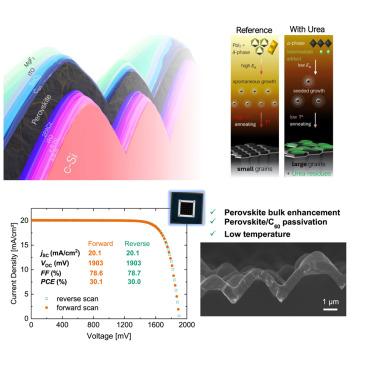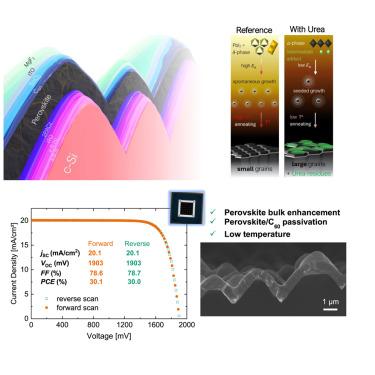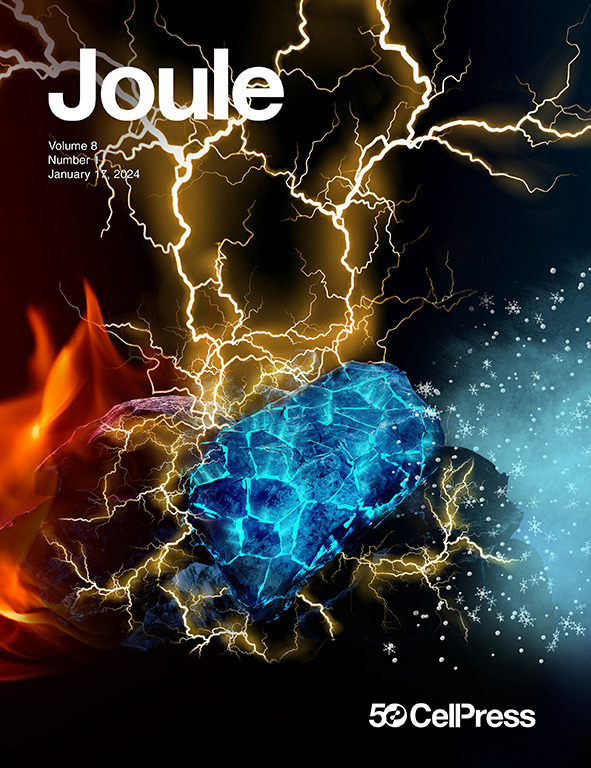Tailoring perovskite crystallization and interfacial passivation in efficient, fully textured perovskite silicon tandem solar cells
IF 38.6
1区 材料科学
Q1 CHEMISTRY, PHYSICAL
引用次数: 0
Abstract
Fully textured perovskite silicon tandem solar cells are promising for future low-cost photovoltaic deployment. However, the fill factor and open-circuit voltage of these devices are currently limited by the high density of defects at grain boundaries and at interfaces with charge transport layers. To address this, we devise a strategy to simultaneously enhance perovskite crystallization and passivate the perovskite/C60 interface. By incorporating urea (CO(NH2)2) as an additive in the solution step of the hybrid evaporation/spin-coating perovskite deposition method, the crystallization kinetics are accelerated, leading to the formation of the desired photoactive phase at room temperature. With that, perovskite films with large grain sizes (>1 μm) and improved optoelectronic quality are formed at low annealing temperatures (100°C). Concurrently, remnant urea molecules are expelled at the perovskite surface, which locally displaces the C60 layer, thus reducing interfacial non-radiative recombination losses. With this strategy, the resulting tandem solar cells achieve 30.0% power conversion efficiency.


定制高效全纹理包晶硅串联太阳能电池中的包晶结晶和界面钝化
全纹理包晶硅串联太阳能电池有望在未来实现低成本光伏应用。然而,这些器件的填充因子和开路电压目前受到晶界和电荷传输层界面高密度缺陷的限制。为了解决这个问题,我们设计了一种策略,可以同时提高包晶石的结晶度和钝化包晶石/C60 界面。通过在混合蒸发/旋涂包晶沉积法的溶液步骤中加入尿素(CO(NH2)2)作为添加剂,加速了结晶动力学,从而在室温下形成了所需的光活性相。这样,在低退火温度(100°C)下就能形成晶粒尺寸较大(1 μm)、光电质量更高的包晶体薄膜。与此同时,残余尿素分子被排出到包晶表面,使 C60 层发生局部位移,从而减少了界面非辐射重组损耗。通过这种策略,串联太阳能电池的功率转换效率达到了 30.0%。
本文章由计算机程序翻译,如有差异,请以英文原文为准。
求助全文
约1分钟内获得全文
求助全文
来源期刊

Joule
Energy-General Energy
CiteScore
53.10
自引率
2.00%
发文量
198
期刊介绍:
Joule is a sister journal to Cell that focuses on research, analysis, and ideas related to sustainable energy. It aims to address the global challenge of the need for more sustainable energy solutions. Joule is a forward-looking journal that bridges disciplines and scales of energy research. It connects researchers and analysts working on scientific, technical, economic, policy, and social challenges related to sustainable energy. The journal covers a wide range of energy research, from fundamental laboratory studies on energy conversion and storage to global-level analysis. Joule aims to highlight and amplify the implications, challenges, and opportunities of novel energy research for different groups in the field.
 求助内容:
求助内容: 应助结果提醒方式:
应助结果提醒方式:


